Abstract
A critical component of community-based disaster preparedness (CBDP) is a local resource database of suppliers providing physical, information and human resources for use in disaster response. Maintenance of such a database can become a collaborative responsibility among community-based non-governmental organizations (NGOs), public, and private organizations in the community. In addition to mobilizing resources, this process raises awareness within the community and aids in assessing local knowledge and resources. This paper presents the results of a pilot study in implementing a community-based resource database through collaboration with local American Red Cross chapters and public and private community organizations. The design of the resource database is described. The resource database is accessible both using the Internet and offline using laptops and handheld PDAs to support disaster response. The study concludes that CBDP is strengthened through a combination of appropriate information technology and collaborative relationships between NGOs and community-based organizations.
Keywords: CBDP, NGOs, emergency preparedness, information technology
Introduction
In any crisis, the ability to retrieve accurate information quickly is critical to assessing and responding to the situation.
Imagine: a nurse arrives at the scene of a local apartment file to find that a low-income diabetic patient has lost his glucometer. The nurse wonders if someone in the community can offer a free glucometer, but cannot quickly retrieve the information at the scene. Or, a community volunteer receives requests for shelter far beyond the bed capacity that a homeless shelter can provide for that night. The volunteer consults the community’s printed resource guide and refers clients to other facilities. Unfortunately, the printed guide is out-of-date, and the clients have no where to go for the night. In the examples cited, a reliable community-based resource for immediately retrieving accurate information is either missing, out of date, or the critical resources are not listed.
Consider a responder from New York arriving to help with a hurricane response in Florida. The volunteer’s home chapter has compiled a comprehensive referral list of resources that are available in the volunteer’s community. After arrival in Florida, the volunteer discovers that the local Florida Red Cross chapter does not have a list or book of community resources. Again, the national responder needs a source of accurate information about community-based resources in the disaster area.
This paper presents results of a pilot study examining the use of information technology to address problems such as those described above. After reviewing the need for and importance of community-based disaster preparedness (CBDP), a proposed information technology solution, the Community Disaster Information System (CDIS), is presented. CDIS is designed to enhance emergency readiness through capacity assessment and community-based partnerships. Results of a pilot study using CDIS to enhance readiness is presented. It provides a model for using information technology to enhance partnerships between non-governmental organization (NGO) responders and community-based suppliers and agencies, thereby strengthening CBDP.
Community-Based Disaster Preparedness
Emergency preparedness refers to the readiness of a political jurisdiction to react constructively to threats from the environment in a way that minimizes the negative consequences for health and safety. It results from a process in which a community examines its susceptibility to hazards (vulnerability analysis), identifies human material resources available to cope with these threats (capability assessment), and defines the organizational structures by which a coordinated response is to be made (plan development) (Perry and Lindell, 2003).
Community-based disaster preparedness (CBDP) refers to a specific form of local-level capacity building and represents increasingly important elements of vulnerability reduction and disaster management strategies. CBDP strategies leverage the knowledge and capabilities of local community resources. Successful implementation of CBDP requires an understanding of the communities involved (Allen, 2006). NGOs, such as American Red Cross or Salvation Army are well-equipped to implement CBDP strategies. Furthermore, it is recognized that governments alone cannot achieve significant, sustainable risk reduction and that greater emphasis must be placed upon local-level and community-based approaches supported by NGOs or other community-based organizations (Turoff et al., 2003; Benson et al., 2001).
Information Technology in Emergency Preparedness and Response
The Internet is cited frequently as an important component for information-sharing during the emergency phase of disasters. Examples include the Internet as a communications tool for providing improved access to literature on natural hazards emergency management and its use as a real-time communications tool and for sharing information in emergencies (Jefferson, 2006; Chan, et al., 2004; Telleen and Martin, 2002; National Research Council, 1999; Stephenson and Anderson, 1997). While researchers expect information technology to have an increasingly important role in information-sharing during emergencies and disasters (Arnold et al., 2004) a recent study found that 42% of local community web sites have no disaster related content and that the 2005 hurricane disasters had little effect on municipal website content (Basolo et al., 2006). Recent experiences with the Katrina response cite the need to strengthen information and communication technology capabilities (Shannon, 2006; Arnone, 2005).
A critical component for any emergency response system is a local resource database that includes physical, informational and human resources (Turoff et al., 2003). Some examples include: construction equipment and operators; medical facilities and personnel; transportation; food, housing, and shelter; and animal shelters.
CDIS (Community Disaster Information System) is designed as the local resource database to serve community NGOs, such as the American Red Cross, and government agencies. The remaining portions of this paper describe the results of the pilot study that can strengthen CBDP using CDIS.
Pilot Study
In 1905, Congress granted the Red Cross authority to provide disaster relief. Although the American Red Cross is not a government agency, the organization provides immediate assistance to an average of 67,000 natural and human-made disasters each year. The vast majority of the responses are to house or apartment fires. The organization’s response to large scale disasters is well publicized through the media. These disasters can include hurricanes, floods, earthquakes, tornadoes, hazardous material spills, transportation accidents, explosions, and terrorist attacks. The Red Cross mission statement states “The American Red Cross, a humanitarian organization led by volunteers, guided by its Congressional Charter and the Fundamental Principles of the International Red Cross Movement, will provide relief to victims of disasters and help people prevent, prepare for, and respond to emergencies” (American Red Cross, 2003). As indicated by the Red Cross mission statement, when a disaster threatens or strikes, the Red Cross works to address basic human needs by providing shelter, food, and health services to victims of disaster. Specific factors such as the type and location, the magnitude, the time of the year and the state of community pre-disaster preparedness directly impact the needs of the victims and the communities affected by the disaster.
When the scope of a disaster exceeds the capability and resources of a local chapter, other Red Cross chapters are called to assist. Red Cross workers from around the country travel to the disaster site. These workers are often unfamiliar with the community in which they will be working and they will need to know where local community services and material goods can be obtained. For example, Red Cross workers will need to know how to access medical equipment suppliers, emergency housing, health facilities, 24-hour pharmacies and public health information. Currently, there is no single uniform information system in place that will provide these Red Cross workers or other disaster responders the information that they need to assist the victims of the disaster.
Without a uniform information system, Red Cross workers rely on hard copy information compiled in loose-leaf notebooks, file folders, and in the Yellow Pages. Local workers may share information informally with other disaster responders in their communities. The information, which is often handwritten, includes names, addresses, and phone numbers of local pharmacies and other suppliers of health-care products, hospitals, food pantries, hotels, emergency shelters and transportation services. This informal process for exchanging information is inadequate and may result in incomplete information that is neither indexed nor easily searched, information that is not uniformly available to workers, duplication of effort, and information that is inaccurate or not timely.
The current process used for information exchange and retrieval during a disaster relief operation of any size is inadequate. This informal information exchange process can frustrate disaster workers and cause delays in response and service delivery to the victims. In an effort to address this problem, researchers at Miami University and the Red Cross embarked on a pilot study to improve CBDP preparedness through the use of the CDIS information system.
Information System
CDIS automates the identification of and access to information on local and national suppliers of disaster related services including health and human services. It provides multiple modes of access, both on and off line, to a central server and database repository over the Internet via the following link: http://www.rdcmiami.org/. The database is housed in the Resource Data Center at Miami University (Oxford, Ohio) and serves as a central data repository for the storage of local community and national resources.
Database records include name, address, online Google map, phone numbers, web site address, hours of operation, a general description of services, Red Cross-specific relationships, languages spoken, and other information for community-based resources. Records have information that can be used for daily social service referrals and specific areas describing how the supplier or agency can assist in a disaster.
Records are entered, ordered and maintained by the local community (Red Cross chapter) and are accessible to any authorized user. Most chapters are situated within a given county or city or predefined jurisdiction (defined by a set of zip codes). Community resources are associated with a given community by matching zip codes. Each local community is responsible for identifying and entering resources within their respective jurisdictions. When resources used by a community are outside the boundaries of its jurisdiction or are national resources such as the Centers for Disease Control (CDC) that could benefit all communities the CDIS system provides a means for adding these resources. For communities that comprise regional oversight for multiple chapters e.g., National Capital Area or are part of a consortium e.g., Washington Metropolitan Area Consortium, zip codes for adjacent counties can be assigned to the overarching chapter or regional authority.
The wide variety of information in the database requires a systematic method for categorization that facilitates effective information searching and retrieval. The system directory provides a hierarchical structure for all data and information as recommended by Turoff et al., 2003. CDIS employs the standard classification system used by information and referral (I&R) agencies, AIRS/INFO Line Taxonomy of Human Services (Sales, 2004). Using a standard I&R classification system offers the possibility for data sharing among different databases. First published in 1987, the taxonomy is a classification system for structuring information about human services. The taxonomy contains more that 8,000 terms that are organized into a hierarchical structure that shows the relationships among terms (Anonymous). There are ten service categories: Basic Needs, Consumer Services, Criminal Justice and Legal Services, Education, Environmental Quality, Health Care, Income Support and Employment, Individual and Family Life, Mental Health Care and Counseling, and Organizational/Community/International Services. Each category is broken down into increasingly specific levels. An example of the hierarchical organization of the taxonomy is shown in Figure 1. This figure shows only a portion of the taxonomy, with selected categories expanded for illustration. Working with the Red Cross chapters, the CDIS system has activated only those categories and sub-levels that are relevant. In addition, resources can also be indexed by the populations served such as age groups, educational status, victims/survivors, and many others identified in the taxonomy as Target Populations.
Figure 1.
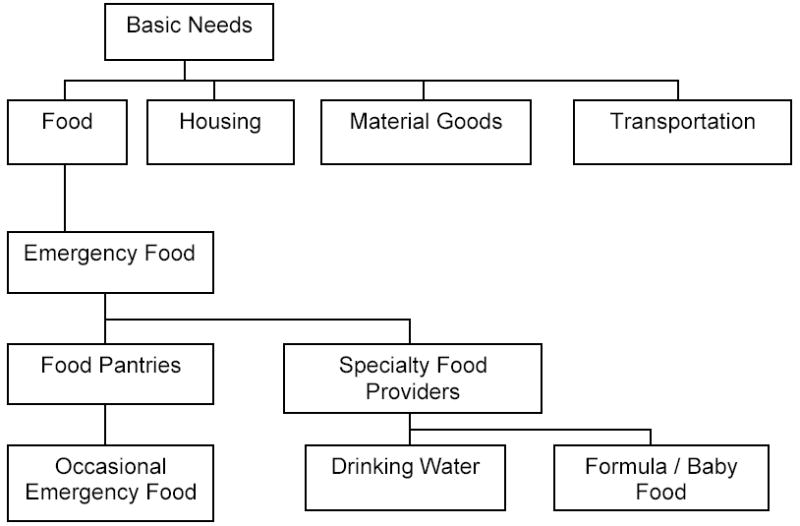
Illustration of the five levels of the taxonomy.
User accounts are created within the chapter to provide secure access to the database. Individual users are assigned database access rights that permit specific database actions. Each community administrator may create and maintain user accounts for staff and volunteers within the chapter. Other users can have rights to enter or edit data or rights to only search and view data. Another feature of CDIS is to create a list of user groups based on category of user (e.g., “Staff”, “Volunteers”, and “Vendors”). Community administrators can utilize these user categories to send email messages to the desired group or to all users.
Entry and maintenance of information in CDIS is accomplished through a web-based system using an Internet browser. CDIS has a robust search capability by taxonomy category, organization name, location, and many other options. To support searching and viewing of information, even in disaster situations, three alternatives are provided: 1) The web-based system, 2) “Standalone” software applications for laptops and handheld PDAs; and 3) Complete printable directory reports. These alternatives are described below.
CDIS Overview
Web-Based Information System
After connecting to CDIS (www.rdcmiami.org/cdis) and
logging in, the user has the option of adding to or searching for information in
their community’s database. Figure
2 illustrates the search screen where the user has searched for
“animals.” Clicking the  icon will display the standard taxonomy
definition of that category. Clicking on one of the animal-related categories
leads to the list of specific community resources. Figure 3 illustrates the results for the “Emergency
Animal Shelters” category and Figure
4 shows the details for the Animal Assistance League of Orange County.
Results showing many records can be refined using the search options that
include: 24-hour services, chapter suggested, languages spoken, specific
counties, or target population (age groups, conditions, etc.).
icon will display the standard taxonomy
definition of that category. Clicking on one of the animal-related categories
leads to the list of specific community resources. Figure 3 illustrates the results for the “Emergency
Animal Shelters” category and Figure
4 shows the details for the Animal Assistance League of Orange County.
Results showing many records can be refined using the search options that
include: 24-hour services, chapter suggested, languages spoken, specific
counties, or target population (age groups, conditions, etc.).
Figure 2.
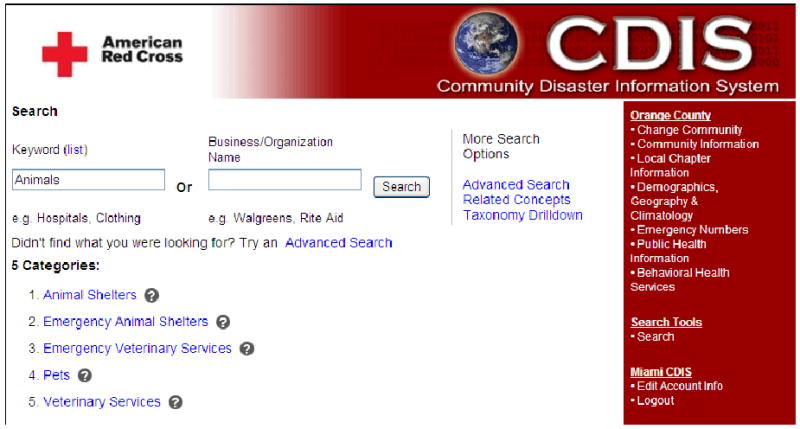
Example of the CDIS interface for category keyword searching.
Figure 3.
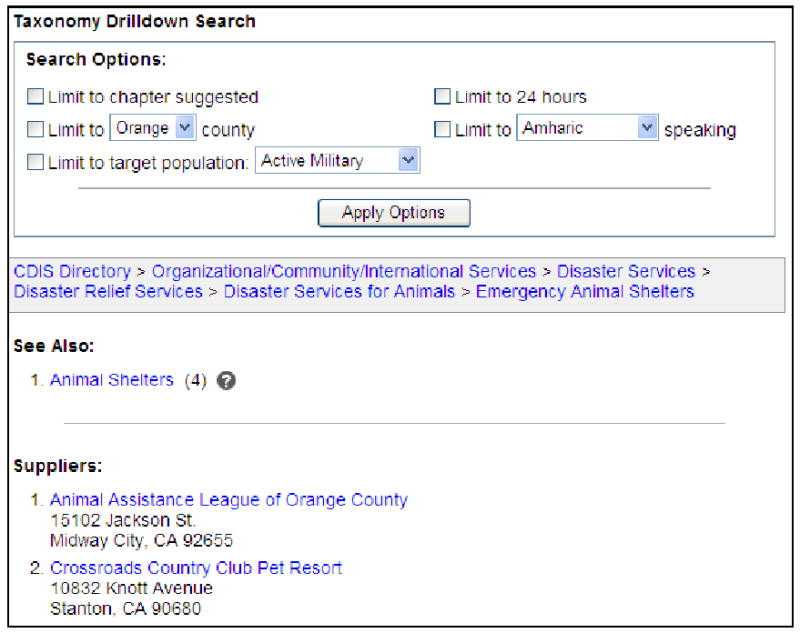
Listing of Emergency Animal Shelters.
Figure 4.
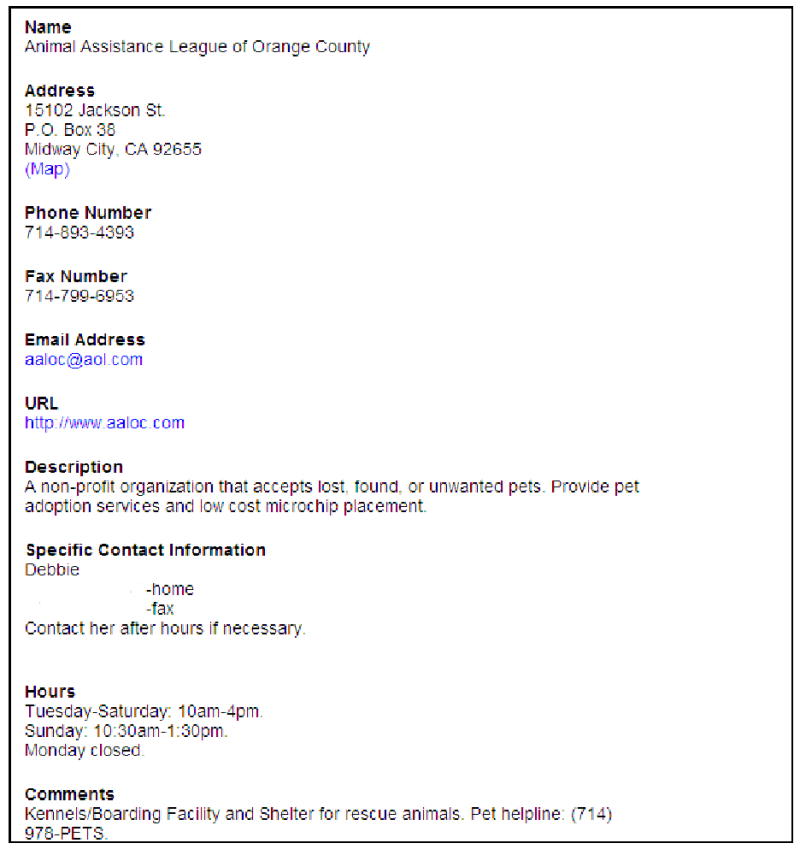
Example of a CDIS resource record.
Figure 4 illustrates a typical resource record. Important information fields, such as Specific Contact Information, are provided to support Red Cross operations. The “map” link in the address field is an automatically generated link to Google maps. There is a Disaster Information box (not shown in Figure 4) that allows partnering agencies to list preparedness information. During a disaster response, the partnering agencies are able to enter additional service information into the database. This feature alerts the Red Cross workers and other disaster responders to expanded services or changes in the normal service delivery of the partnering agencies. A link (not shown in the figure) is also provided for a printer-friendly copy of the resource record.
An alternative to keyword search is the “list” search (see upper left corner of Figure 2 for the link) illustrated in Figure 5. This screen displays a list of the lowest-level taxonomy categories that contain information. It is a very convenient way for casual users to browse resource categories. Selecting Emergency Animal Shelters in the List search screen would display the same results as illustrated in Figure 3.
Figure 5.
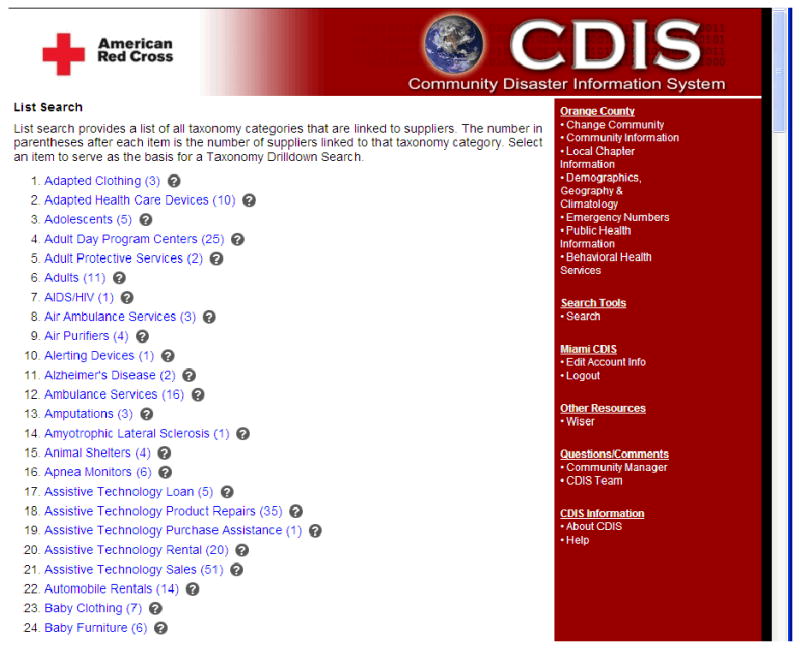
Browsing categories with Information.
Additional searching options are listed under “More Search Options” (upper right corner of Figure 2). Advanced search provides for location specific searches such as street address or zip code. The Taxonomy Drilldown search allows the user to browse the taxonomy from the top down by category. Related Concepts search cuts across the taxonomy to group together categories that are related in ways not captured by the hierarchical structure. Figure 6 shows a partial listing of the related categories and Figure 7 shows the screen for the Disaster Services related categories. The Disaster Services section was developed in conjunction with the National Emergency Response Information Network project (AIRS NERIN).
Figure 6.
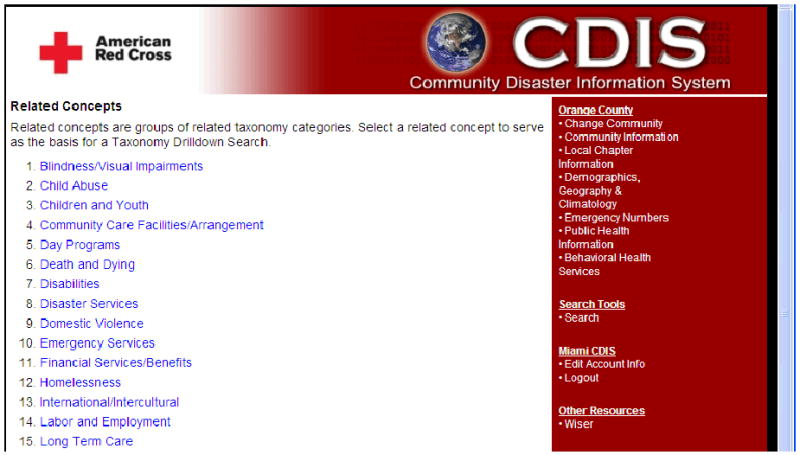
Related categories provides another view of the taxonomy.
Figure 7.
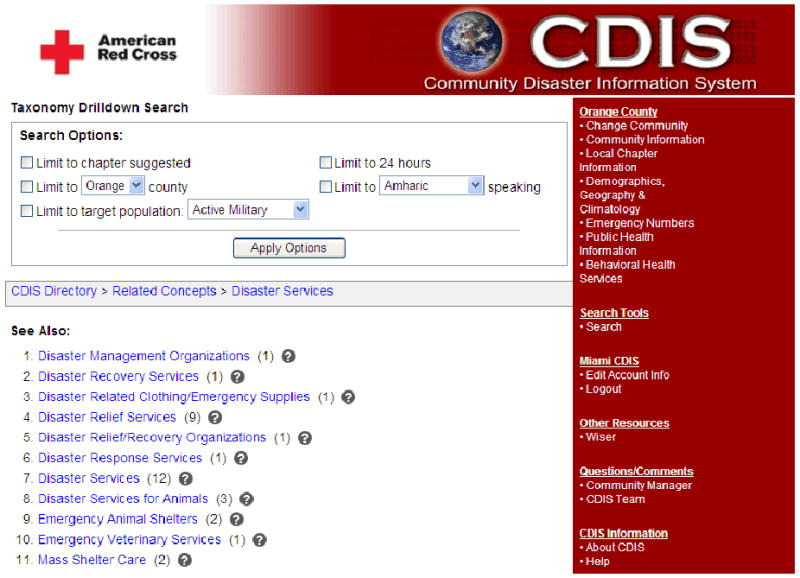
Taxonomy Categories under Disaster Services related category.
CDIS provides a wide variety of additional screens and functions. These include:
Data entry and editing: Screens similar to Figure 4 in which users enter information.
A variety of “reports” used to produce hard-copy reference material of resource information by category or county.
Administrative screens: Screens for maintaining user accounts and for communicating with users, including an announcement page and automated email messages.
A key feature of CDIS for disaster workers is that any valid user can search any chapter’s resource information. This feature enables neighboring communities to search each other’s databases for mutual aid.
CDIS in Disaster Situations
Since providing reliable Internet access to multiple mobile users in large-scale disasters is not feasible at this time (Arnold et al., 2004), the CDIS system provides two alternative software modules: One for laptop (or desktop) PCs and a second for Personal Digital Assistants (PDAs). In both cases the CDIS search engine software must be installed on the laptop or PDA where it appears as a typical application. When Internet connectivity is available both platforms download a copy of the database and store it locally on the hard drive or in flash memory (RAM). For example starting the CDIS application on a regular basis (weekly or monthly) will assure that a fresh copy of the database is stored locally on the machine. Since laptops and handheld devices have an independent power source for use in the field where power and communication infrastructure may be disrupted once the database is downloaded it can be searched requiring no Internet connectivity. By using CDIS on a laptop or PDA emergency workers can search the database in disaster situations making the data accessible even in situations where power and communication are temporarily disabled. Figure 8 illustrates the “standalone” laptop search program and figures 9 and 10 illustrate the PDA program.
Figure 8.

CDIS laptop software for Internet-independent searching.
Figure 9.
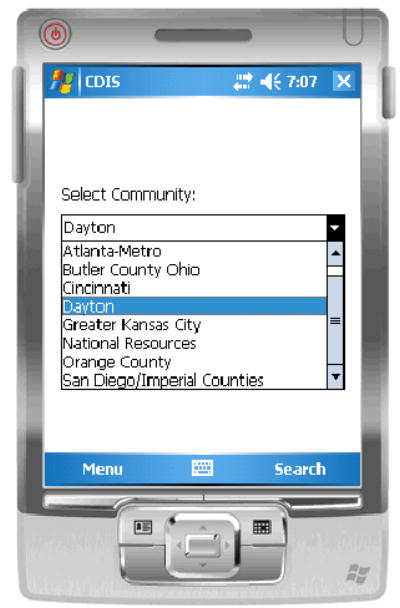
CDIS on a PDA (selecting a community for downloading).
Figure 10.

Resource Information
Printed Reports
The web-based system has the ability to provide standard reports to produce a hard copy supplier directory, statistical reports, and user activity reports. Reports ordered by county within a community are also available. Printing the directory report on a regular basis provides additional alternative access to the community’s information.
Impact
Assessment of the effectiveness of CDIS was conducted over a two year period using individual interviews with Red Cross chapter managers in semi-annual focus group meetings and written surveys. The test sites represented a variety of U.S. locales and ranged from modest-sized areas (for example, Dayton, Ohio) to larger areas (for example, Orange County, California). During the assessments, we studied the processes and procedures of Red Cross chapters to identify how we could refine CDIS to more effectively impact chapter response and readiness in times of disaster.
Recent national and statewide studies of human services information and referral systems have identified a variety of potential benefits for individuals, community organizations, and society (Fisher, et al., 2005; O’Shea, et al., 2004; Shank and Rosenbaum, 2003). Table 1 lists the benefits that users of CDIS identified.
Table 1.
Benefits Identified by CDIS Users.
| Beneficiary | Benefits |
|---|---|
| Individual | CDIS benefits individual users by:
|
| Organization | CDIS benefits organizations by:
|
| Society | CDIS benefits society by:
|
Benefits to Individuals
Improving information coverage through a continually expanding database; serving a broad range of information needs
Pilot sites utilized CDIS to serve displaced Katrina victims. The Greater Kansas City Missouri Red Cross chapter used the taxonomy target population category “Hurricane Victims” to index resources earmarked for Katrina victims. Volunteers and staff identified 167 relevant community resources in the following categories: Basic needs; criminal justice and legal services, healthcare; income support and employment; individual and family life; mental healthcare and counseling; and organizational and community/international services. The Metropolitan Atlanta Chapter, Georgia, used CDIS to better serve displaced Katrina clients with accurate information and location for referrals. The Group Lead volunteer at the Metropolitan Atlanta chapter reported: “As we expand our database to include food, hotel, shelter, and other community resources, the online access to CDIS will provide Client Services (Health Services, Mental Health Services, Client Casework and Welfare Information) volunteers with resources throughout our service area and beyond for meeting the needs of our clients.”
Including data about appropriate, local resources; containing quality referrals for services
CDIS quickly evolved into an important asset for storing client referrals for the Orange County California Red Cross chapter. The chapter uses the system to maintain relationships and information across the spectrum of county providers. The chapter has indexed 1,519 community resources in 171 different categories. Prior to using CDIS, the chapter could not effectively filter inappropriate referrals for social service agencies, which often resulted in the client not receiving the services. Since CDIS capably manages detailed contact information, the Orange County chapter can now identify the right person at the right agency to make successful referrals, and thereby reduce expenditures for client assistance by the American Red Cross.
Benefits to Organizations
Improving the monitoring of service referrals
The Arlington County, Virginia (Washington D.C. Metropolitan Area) Red Cross chapter used CDIS to assist some of the nearly 7,000 Katrina evacuees in their community. The chapter CEO and Chief Preparedness and Response Officer stated: “DHS [Disaster Health Services] volunteers used CDIS to track health professionals volunteering their services to assist with everything from eyeglasses, to hearing aids, to prosthetics. Sharing a common database, staff and volunteers were able to successfully manage and track resources used and available better than ever before. Multiple volunteers, with different system access levels, could simultaneously enter new data, search for resources, and edit existing entries.”
Encouraging chapter and community collaboration
The Greater Cincinnati Ohio Area Red Cross chapter and the Cincinnati / Hamilton County Ohio Emergency Operations Center (EOC) use CDIS to cooperatively maintain and expand their database. The EOC maintains information about emergency-response equipment (for example, cranes, bulldozers, and dump trucks), and the Red Cross chapter maintains crucial emergency information for families and individuals. The Cincinnati Red Cross Director of Preparedness states, “This regional collaboration will help the Red Cross meet the needs of the community and ultimately the disaster victims.”
The Dayton Ohio Area Red Cross chapter formed the CDIS Partnership with the United Way of Greater Dayton Area (UWGDA) to cooperatively share database information between the UWGDA’s HelpLink 2-1-1 Human Services Information and Referral Database and CDIS. This collaboration benefits the chapter and the greater Dayton community. The Dayton Red Cross Chief Emergency Services Officer states, “CDIS has been the catalyst in developing relationships with our area 2-1-1 and HelpLink agencies who are very interested in sharing our data in CDIS with their information systems.”
A standard, community-level database can support readiness efforts at the community, state, and national level. The Director of Red Cross Disaster Services for the Orange County California chapter states, “Our history suggests that CDIS is the answer to an often asked question about how response information can be easily collected, maintained, and shared across a variety of local government and agency partners.”
Sharing the responsibility for data collection
An effective approach to maintaining the CDIS database is to share the responsibility of creating and updating information to each community agency. The Orange County California Red Cross chapter creates a CDIS account for each partner agency, and the agencies are responsible for maintaining accurate and comprehensive information about their programs. The Red Cross chapter facilitates CDIS training for agencies, and once trained, they can regularly update the database with information and referrals. Chapters can send emails through CDIS to remind agencies to periodically verify the accuracy of their data. Partnering agencies can use CDIS for client referrals, and thereby increase the buy-in of more agencies. In times of disaster, agencies can dynamically update their data in CDIS, which allows Red Cross chapters to solely focus on providing emergency services.
The community collaboration that CDIS facilitates can further increase the role of CDIS as a comprehensive resource of disaster-specific information and result in better preparedness for disasters.
Strengthening volunteer recruitment and retention
Red Cross chapters oftentimes only use volunteers in times of disaster. This infrequent use of volunteers can negatively impact volunteer retention and their knowledge about their community’s disaster resources. However, chapters can use CDIS to engage volunteers to expand and maintain the database to support Red Cross activities.
Volunteers who have mobility or transportation constraints can engage in virtual volunteering by developing the CDIS database from home via the Internet. Virtual volunteerism does not a substitute for local chapter volunteers but instead allows another method for community partners and working individuals to contribute to the project. Virtual volunteerism also has significant potential to recruit and retain volunteers who have limited hours to contribute to the Red Cross. In the Greater Atlanta Georgia and Arlington County Virginia Red Cross chapters volunteers with demanding professional hours have successfully managed the CDIS database by working from home over the Internet.
Virtual volunteerism through CDIS has effectively mobilized younger, tech-savvy volunteers at many of the pilot Red Cross chapters. The Kansas City, Cincinnati, and Dayton chapters leverage university students for data entry and database maintenance. In the Orange County California chapter, volunteers created the welcome and chapter information pages for the database. Virtual volunteerism has also provided opportunities for retired professionals to apply their talents to further develop CDIS databases.
Benefits to Society
Increasing civic engagement; structuring opportunities for networking among stakeholders, including public sector and community-based services
Red Cross chapters can use CDIS to store agreements with local organizations that provide services and supplies based on Red Cross referrals. For example, the Orange County California Red Cross chapter partners with a community-based dental clinic to provide low-cost denture replacements to clients referred by the Red Cross. The chapter also has a relationship with a local college of optometry to provide low-cost, replacement eyeglasses for disaster victims. In another instance, the Orange County Chapter works with a community-based agency that provides childcare staff in Red Cross shelters and replaces baby supplies for Red Cross in times of disaster. The Orange County Chapter uses CDIS to store these agreements, and numerous others, into a consistent format that Red Cross volunteers can easily access in times of disaster.
Conclusion
A database of community-based resources helps communities to prepare for and respond to emergencies. Community organizations with available resources for emergencies have an efficient and structured means of maintaining data about the products and services they offer. Red Cross executives and workers report that the Community Disaster Information System improves service coverage and efficiency, increases information on available resources, helps monitor and provide for quality referrals, encourages community collaboration and networking, and assists with recruitment, training, and retention of Red Cross volunteers.
Although construction and maintenance of a resource database can be a considerable expense for government entities and NGOs, the CDIS pilot Red Cross chapters have demonstrated the ability to economically maintain the database through a collaborative, dispersed responsibility among the members of the local community. The collaborative process of constructing, gathering, and maintaining information in a single source raises awareness of risk and vulnerability in the community, assesses local knowledge and resources, and mobilizes local resources. The partnerships created during the CDIS pilot study led to new service offerings for the Red Cross clients and provided more effective client referrals. The Red Cross workers could devote more time to working with clients and less time to locating services and performing data entry and maintenance tasks. Community partners also benefited from the ease with which they could access information in the CDIS database.
The CDIS system provides data entry tools, a robust search engine, report generation, administrative tools and communication facilities. To provide a systematic method for categorization of information in the database CDIS employs the AIRS/INFO Line Taxonomy of Human Services. Although the primary user interface for CDIS is through an Internet browser to the web site the search engine is also available as an independent software program for handheld PDAs and laptops. When Internet connectivity is available the independent PDA and laptop versions download a local copy of the resource database into local hard drive (or flash RAM) storage. The local database is then accessible independent of Internet connectivity. In this way the CDIS system can be used in severe disaster situations where power and communication infrastructures are disrupted. Hardcopy directory reports provide for another means of access to the information.
From major disasters such as the Katrina hurricane to daily client referrals the CDIS pilot study demonstrates that a local resource database benefits individuals, organizations and society in preparing for and responding to emergencies thereby strengthening community-based disaster preparedness.
References
- American Red Cross. [Accessed on September 8, 2006.];FAQs . 2003 http://www.redcross.org/faq/0,1096,0_315_,00.html.
- Allen KM. Community-based disaster preparedness and climate adaptation: local capacity building in the Philippines. Disasters. 2006;30(1):81–101. doi: 10.1111/j.1467-9523.2006.00308.x. [DOI] [PubMed] [Google Scholar]
- Anonymous Structure and Contents of the Taxonomy. [Accessed on May 16, 2006.]; http://www-211taxonomy-org/publicfiles/view/Intro-Structure_and_Contents.pdf.
- Arnold JL, Levin BN, Manmatha R, Lee F, Shenoy P, Tsai MC, Ibrahim TK, O’Brien DJ, Walsh DA. Information-Sharing in Out-Of-Hospital Disaster Response: The Future Role of Information Technology. Prehospital and Disaster Medicine. 2004;19(3):201–207. doi: 10.1017/s1049023x00001783. [DOI] [PubMed] [Google Scholar]
- Arnone M. IT crucial for FEMA reform, FCW.COM. [Accessed on May 25, 2006.];2005 http://www.fcw.com/article91161-10-19-05-Web.
- Benson C, Twigg J, Myers M. NGO Initiatives in Risk Reduction: An Overview. Disasters. 2001;25(3):199–215. doi: 10.1111/1467-7717.00172. [DOI] [PubMed] [Google Scholar]
- Basolo V, Steinberg L, Gant S. E-Government and the Preparation of Citizens for Disasters. Proceedings of the 2006 National Conference on Digital Government Research; San Diego, CA. 2006. pp. 255–256. [Google Scholar]
- Chan TC, Killeen J, Griswold W, Lenert L. Information Technology and Emergency Medical Care During Disasters. Academic Emergency Medicine. 2004;11(11):1229–1236. doi: 10.1197/j.aem.2004.08.018. [DOI] [PubMed] [Google Scholar]
- Fisher KE, Saxton M, Naumer C, Pusateri C. WIN 2-1-1: Performance Evaluation and Cost-Benefit Analysis of 2-1-1 I&R Systems. The Information School, University of Washington, Box 352840; Seattle, WA, 98195, USA: 2005. [Google Scholar]
- Jefferson TL. Using the internet to communicate during a crisis. VINE: The journal of information and knowledge management systems. 2006;36(2):139–142. [Google Scholar]
- National Research Council. Reducing Disaster Losses through Better Information. National Academy Press; 1999. pp. 1–61. [Google Scholar]
- O’Shea D, King CT, Greenfield S, Shelton E, Sullivan L, Taber E, Olson JA. National Benefit/Cost Analysis of Three Digit-Accessed Telephone Information and Referral Services, Ray Marshall Center for the Study of Human Resources, Lyndon B. Johnson School of Public Affairs, University of Texas at Austin; Austin, TX, 78703, USA: 2004. [Google Scholar]
- Perry RW, Lindell MK. Preparedness for Emergency Response: Guidelines for the Emergency Planning Process. Disasters. 2003;27(4):336–350. doi: 10.1111/j.0361-3666.2003.00237.x. [DOI] [PubMed] [Google Scholar]
- Sales G. The Journal of the Alliance of Information & Referral Systems. Vol. 26. 2004. An Orientation to the Structure and Contents of the AIRS/INFO LINE Taxonomy, Information & Referral; pp. 1–26. Special Issue: The Resource Database. [Google Scholar]
- Shank NC, Rosenbaum DI. Examining the Potential Benefits of a 2-1-1 System: Quantitative and Other Factors, Information & Referral. The Journal of the Alliance of Information & Referral Systems. 2003;25:1–25. [Google Scholar]
- Shannon MM. The Network of Life. Communications of the ACM. 2006;49(1):29–32. [Google Scholar]
- Stephenson R, Anderson PS. Disasters and the Information Technology Revolution. Disasters. 1997;21(4):305–334. doi: 10.1111/1467-7717.00065. [DOI] [PubMed] [Google Scholar]
- Telleen S, Martin E. Improving Information Access for Public Health Professionals. Journal of Medical Systems. 2002;26(6):529–542. doi: 10.1023/a:1020244726109. [DOI] [PubMed] [Google Scholar]
- Turoff M, Chumer M, Van del Walle B, Yao X. The Design of a Dynamic Emergency Response Management Information System (DERMIS) Journal of Information Technology Theory and Application. 2003;5(4):1–36. [Google Scholar]


